|
Possible causes
Crossover Slopes
What's To Be Done
Vandersteen/Thiel/Dunlavy
Response
The Note
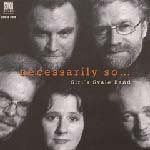 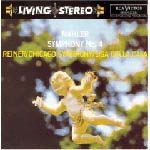 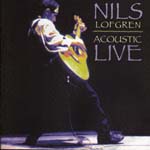 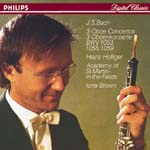 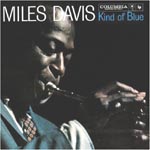 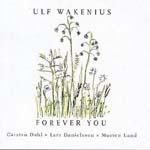 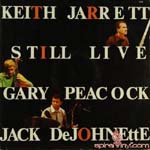
A
few of the recordings used in speaker evaluation. To the
left Siri's Svale Band and Mahler's 4th used specifically
in this study.
For
fine-tuning of crossovers, I obviously have a
range of well-known CDs and vinyls to hear how my
speakers perform and to correct tonal balance in the
final crossover. One of the CDs are Siri's Svale Band
(Norway) and on track 4, You Make Me Fell Like a
Natural Woman, she goes solo and a few seconds into
the song she sings: " - and when I knew I had to
face another day -". The word "another"
is a "clean" D, 293.66 Hz, and she sings it
very loud and most speakers simply can't cope with it -
when it also has to be played loud.
To see what was going on with this note I made a FFT plot
of the sound and it turned out like seen below. Multiple
harmonics reaching beyond usual point of crossover up to
~4700 Hz. Some of the harmonics are even higher in
amplitude than the basic note!

The note "D" on the piano.
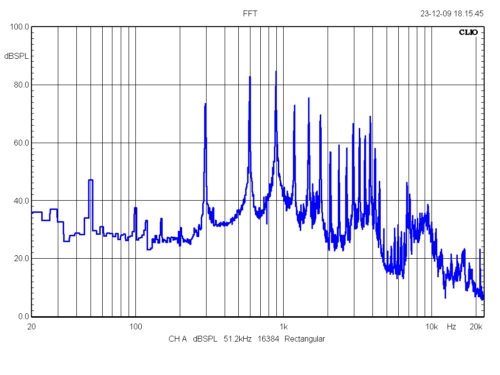 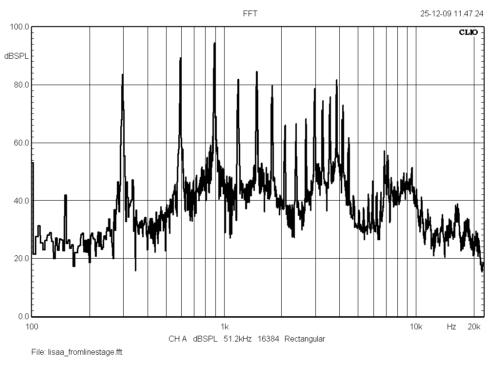
Left: Siri's note D when singing the word
"another". Basic note is 293.66 Hz - with
multiple harmonics. The CLIO actually says 295.9 Hz, but
I guess she hits the note pretty well. To the right the
signal taken directly from the line stage. It's difficult
to hit exactly the same moment of recording, but
basically we see the same pattern as what comes from the
speaker.
This is what it sounds like: Click
here to hear wav file
(400 KB). Click here to go to page on
creating a test track for speaker evaluation.
What I think Siri is doing is
actually overstraining her voice, producing a multiple of
overtones. I'm not talking artistic quality here. I very
much enjoy what she's doing, but for comparison I did the
same thing with Lisa Della Casa from Mahler's 4th
Symphony, 4th movement. Lisa's vocal is tougher to follow
on a FFT plot as we have the orchestra
"blurring" the image, but here and there it was
possible to "see" what she was doing. First of
all she generally sings an octave higher than Siri and
most noticeable, the notes are extremely clean compared
to Siri's D note. I can play this part of Mahler's
symphony loud without speakers getting into trouble.
Obviously Lisa's "notes" have overtones
creating the particular "sound" of her voice,
but not nearly as extended and high in amplitude compared
to Siri's killer note.
Possible Causes
Back to
index
There are a number of observations
in connection to this:
- A number of (modern) drivers with kapton voice coil
former have trouble reproducing Siri's note compared to
speakers with aluminium voice coil former.
- Small (mid-) drivers have trouble too due to
insufficient membrane area creating nonlinear distortion,
or - "basically due to insufficient linear volume
displacement capability" as a well-known open-baffle
constructor once put it when asked why a 4" driver
didn't make it in an open baffle.
- A number of fullrange drivers do it fairly well, e.g.
Supravox 215RTF, vintage SEAS 21 TV-G and 17TV-something
but surely not the Lowthers and vintage Wharfedale Super
8. It has to added that fullrange drivers only do this
well when either listened to off-axis or in a 2-way
set-up with a point of crossover above the usual 3 kHz
point.
- Beaming is another important issue here; that is when
wavelength approaches the diameter of the radiating cone.
- I often do both series and parallel crossover in a new
construction and I have never experienced one type doing
better that the other with regard to this particular
problem. Despite this, I feel certain that crossover
topology (order of filter) plays a significant role too
due to harmonics being spread all over the crossover
region and the inability for higher-order filters to
deliver correct impulse response.
Statements like these
take a few comments because they are based and a limited
number of observations as I don't have an infinite range
of drivers and I haven't done a large number of
experiments, but for what they are worth, here are my
observations:
Kapton voice coil formers
With
the quest for low compression and proper ventilation,
most manufacturers these days use quite long voice coil
formers making a significant distance from the actual
voice coil windings to the cone. Having a long tube here
may create resonances not experiences before where the
cone would be only a few millimetres from the windings.
The standard two-layer windings provide significant
strength to the voice coil former, but having a 15-20 mm
thin kapton (plastic) tube transferring the energy from
the voice coil to the cone may pose problems. Together
with all other moving parts of a driver, an energy
build-up (resonances) may take place and be released once
mass vs. frequency becomes too high and we see a rapid
decline in acoustic output. It may look like this from an
otherwise very high quality 5" middriver:
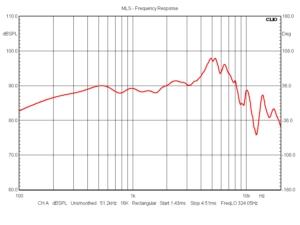
First
of all it's a bit of a pain to make a smooth roll-off
from this driver at the intended 2.5-3.5 kHz point of
crossover and no matter which tweeter I add, it won't do
Siri's "D" from 2nd and 3rd order filters,
series or parallel, BUT, running it 1st order - with a
notch-filter to reduce the 5 kHz peak - does it!
Fortunately I had a tweeter with magnetic oil that
allowed an - almost - first-order filter and although
having to run the tweeter with inverted polarity, it goes
very well compared to the higher order filters. Generally
it takes darn good midrange drivers and tweeters to cope
with 1st order filters.
I have done the ScanSpeak
18W/8545-00 and K00 drivers many, many times and the -00,
having an aluminium voice coil former, has always had a
better upper mid compared to the -K00, which is fitted
with a kapton voice coil former. The -K00 may produce a
speedier bass but at the expense of upper mid quality.
There are exceptions to this like the ScanSpeak
15W/8530-K00 also having a kapton voice coil former. I've
never had serious problems with this driver and it seems
like certain combinations of materials and overall
construction of the driver may add to the problem. Maybe
the sliced paper cone is more tolerant compared to the
paper-carbon composite of the classic range of midbass
drivers from SS.
Too small mid-drivers
If the membrane area isn't big enough we may
have un-linear distortion. The driver simply can't play
loud enough. No big deal, choose a bigger one as a
starting point.
Fullrange drivers:
My experience here is limited, but a few drivers
I have tested (some vintage) do Siri's D fairly well.
Which points to the problem of phase and impulse
correctness. The Supravox and vintage SEAS 21 TV-G and
SEAS 17 TV-something (from an old B&O speaker) all do
it well - until a certain level where the thin paper
cones simply can't cope with the power input and the
sound gets rough and congested from serious cone
break-ups. No wonder. The lack of any crossover in the
2-5 kHz range with the inevitable problems of phase shift
and impulse distortion, etc. tells its story. It also
appears the whizzer cone full-range drivers are not the
way to go. The mechanical crossover in whizzer cone
drivers doesn't seem better than a poorly constructed
higher order passive crossover. Often we see sharp phase
shift in the treble range from whizzer cone drivers and
they do not please the ear.
As mentioned above, beaming plays a role for full-range
drivers and when listened to strictly on-axis they don't
do too well either.
All in all an incomplete and complex set
of observations.
Experiments on crossover slopes
Back to
index

Above a crossover simulation for a 3-way
crossover. During optimisation minor changes were made to
the bas-mid section, but this had little impact on
overall sound. Overlaying the plots makes a messy
picture, but I think it's useful to illustrate the
experiment. To the right I have added thick lines to
enhance the basic crossover topology for the mid-tweeter
section:
# 1 is a 3rd order filter, # 2 is a 2nd order filter and
# 3 is - an almost - 1st order filter.
Polarity of drivers:
# 1: With reference to bass driver (positive polarity) M
and T have negative polarity.
# 2: With reference to bass driver (positive polarity) M
connected with negative polarity and T connected with
positive polarity.
# 3: With reference to bass driver (positive polarity) M
and T connected with negative polarity.
To cut a long story short:
3rd and 2nd order filters can't cope with Siri's
"D" although 2nd order is better than 3rd
order.
The 1st order crossover does it significantly better than
3rd and 2nd order. Going through all my reference CDs,
the 1st order crossover did all difficult tracks better
than I've heard before.
1st order filters here turns out to be close-to-1st-order
on the electrical side and close to 2nd LR on the
acoustic side. True 1st order filters are indeed very
difficult to achieve for almost any driver as they need
to be fairly linear well beyond point of crossover.
More experiments:
a. An LCR circuit was applied to smooth tweeter impedance
and this has no impact on performance, i.e. distortion
measurements and sonically even when driven at
excessively high levels (tweeter with magnetic oil used
in experiment).
b. Adding an all-pass filter to # 3 to have mid and
tweeter connected with same polarity, did not enhance
sonic performance either. It did sound a little different
maybe due to the signal having to pass two 47 uF standard
polyprop caps. I was surprised not hearing any
subjectively sonic degradation of treble performance from
this - - but had to revise this impression later in final
set-up (proper room and amplification).
Updates:
Moving some 130 kgs (!)
speakers and JungSon amp into our living room quickly
required an update. The all-pass filter just didn't
perform once the XX2 cartridge was in front. My first
impression of the all-pass filter just didn't hold. Guess
the standard polyprops after all can't deliver the level
of transparency needed and at high levels treble got
rough. Hmm... So, back to previous crossover version with
inverted tweeter polarity and I added the impedance
flattening circuit to the tweeter - and a little further
attenuation (1 dB). Better. Much better! Which points to
the fact that speakers should always be tested in
different rooms, with different equipment, etc., before
the final crossover is put on paper.
What are we going to make of all
this?
Back to index
Are
we going to ditch all speakers not using 1st order
filters? I mean, these pages - and most of what is found
on the web - are full of speakers with higher-order
filters. I don't think so. No speaker is perfect anyway
and even the best are full of compromises.
There is an abundant amount of literature available on
1st order filters and for some people it has taken almost
religious proportions.
Most drivers can't cope with 1st order
filters due to the huge overlap between drivers and in many cases we
risk frying our tweeters
when cranking up the volume. I have tried many times
during crossovers modeling to see if 1st order filters
are possible, and in most cases it can't be done due to
phase and frequency response in combination with
inadequate placement of drivers, i.e. the front panel
would have to be stepped to acoustically align drivers
(aligning assumed position of voice coils doesn't work),
something that is not always needed, but often is when
dealing with first order filters.
Some people think that a first order filter is a coil and
a cap and that's all. It isn't, unless we settle for
serious compromises. Good 1st order filters are often a
serious amount of crossover components to liniarise
impedance, to smooth roll-off characteristics and to
equalise the usual anything but linear frequency
response. Sometimes it pays off, sometimes it doesn't.
One of the
good questions is how far beyond point of crossover must the response be
1st order? There are no rules for this, but my best estimate is 2
octaves, but I can see from measurements of 1st order speakers, this is
far from standard.
Vandersteen/Thiel/Dunlavy
Back to
index
Vandersteen is a guy who for
decades has worked on 1st order filters and unfortunately
his speakers are not common on these shores - because I'd
like to hear his constructions. What it has taken for Vandersteen to get this far is stepped cabinets,
specially designed drivers, complex crossovers and not
least below average speaker efficiency of 85 dB (3a),
something that doesn't make more than average dynamic
speakers. There's a good interview here, and the
"problem" is that the guy is right, but it
comes at a price. And let's make one thing clear: The use
of complex crossover to realise e.g. 1st order filters
does not count for low efficiency. Many people think that
complex crossovers suck up energy and reduce efficiency.
Not true. The reason for low efficiency is only when we
require deep bass from small speakers. View a 1st order
filter for a 3-way speaker from Thiel. Quite a lot of
components to realise a 1st order filter! Lots of - presumably -
all-pass sections, impedance linearisation, etc.
The reason for low efficiency of Vandersteen speakers is
due to targeting good low-end extension from a fairly
small footprint and to some extent the use minimum
baffle. We get what comes from the driver - and no more. Very contrary
to the wide baffle systems like the Sonus Faber Stradivari.
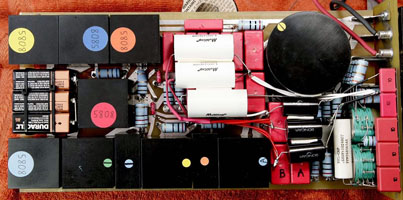
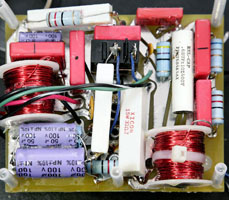
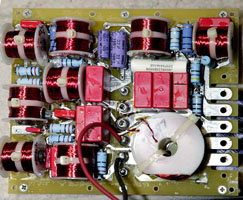
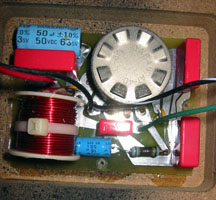
Vandersteen crossovers. A coil and a cap?
Sorry, it doesn't work that way.
Vandersteen interviews and articles:
SoundStage-Richeard-Vandersteen.pdf
Ken-Kessler-Richard-Vandersteen.pdf
Thiel Paper:
Thiel, Coherent Source Loudspeakers
John-Atkinson-Thiel-Coherent-Source
Dynaudio has always made
a trademark of 1st order filters although they don't talk
too much about it any more, maybe because some of their
speakers really are not true 1st order constructions - or
maybe because the discussion on 1st order filters really
doesn't hold commercial value due to the complex issue,
leaving most customers bewildered and confused.
Thiel
(discontinued brand) is the last I want to mention
of the manufacturers that are true believers in 1st order filters and -
like Vandersteen - has
done at lot of research in developing drivers that can
cope with this.
Also Dunlavy's speakers are no
longer around, another true believer in 1st order
filters.
Siri's "D" is not a
typical problem. Fortunately most music does not
to such extent expose the inability of our speakers to
perform this kind of reproduction. But it does tell that
the majority of our speakers really do not sound right
and that time and phase distortion are issues that should
be addressed whenever possible. Based on modeling, a
large number of drivers will require stepped front
baffles to achieve 1st order roll-off, even sometimes for
perfect 2nd LR roll-off.
We have learned to live with speakers where few of these
problems have been addressed, and should someone tell you
he has made a speaker that does it all right, take great
care. This speaker doesn't exist.
This page
-
may be revised from time to time when more experiments
and observations may require changes to statements and
conclusions. Don't think I think I've got it right and
feel free to mail your comments.
Response
Back to index
Response from Peter Wojcik
First of all let me thank you for the advice on
the CSM construction, I knew tweeters were very similiar
but i didn't realize they were so identical. Thanx again.
Your article on Siri's killers note, I found it very
interesting and intreaging. For some reason I always was
a fan of low order x-overs not knowing about the problems
higher orders would create.
Once you mentioned Vandersteen, red light in my head
went off, because a few months ago I was doing a job out
of town about 300 km away and as usual after work I would
go and check out all of the local electronics stores..
One of the stores I visited had a pair of Vandersteens
Model 1C, so the plan became crystal
clear that was gonna be my starting point of 1st order
research.
Investigation: Armed with my copy of a cd I went
off, and just as I suspected and you predicted the
Vandesteen played the track perfectly with out even a
hint of trouble. Lucky for me the same store also
caarried my favourite speakers: SonusFaber,
Auditor M performed flawlessly, same
as Guarneri
Memento.
Next went Minina
Vintage it played well but not as good as the
other two. And by the way Auditor M & Guarneri
are my all time favourite speakers. And they are based on
two drivers that you know so well .S.S 15W and Audio
Technology.
Next day i visited another dealer and I listened to
Totems
-Hawk, it performed great but Dynaudro
X12 Excite didn't, which makes me wonder if
it really is 1st order filter. Since then I have
auditioned BW XT2, Gershman
X-1R, Thiel
CS1.6 and Vienna
Acoustics Haydn Grand. They all
performed flawlessly, which confirms your suspicion about
1st order filters. I have listened to other speakers from
same brand with 2nd or 3rd order filters and they all had
same problem in the same spot as you wrote in yout
article.
The original Auditor from Sonus faber used
unmodified version of 15W a Vifa XT and was 1st
order filter as well, so i hope you don't get offended by
my humble suggestion to try modelind 1st order cross over
for your Ellam XT, which by the way I'm enjoying
immensly - thank you.
If you come up with some new x-over for that project and
are not 100% to your satisfaction I would love to
see it even if you decide not to post it on your
website. I never realized that all the speakers I've
enjoyed through the years and somehow made an impact on
me, had one thing in common --- they were mostly 1st oder
filtered.
I hope you come up with some new 1st filters for existing
or new constructions. Great work on your part which I
have enjoyed so much. Thank you. I am almost finished
with the CSM project and as soon as can I will send you
some pics of what I have done.
Response from Joe Rasmussen
It's
interesting that at least one designer, Troels Gravesen,
has heard audible effects from the type of former that
the VC is wound on, preferring Aluminium over Kapton.
Could it be that the former has a significant effect over
the VC's heat distribution? He also notices the same
effects on drivers he considers having an inadequate Sd,
the cone area. If the conceptual theory is correct, then
larger Sd will lessen the audible effects of non-linear
VC heat distribution.
Read more here: http://customanalogue.com/elsinore/elsinore_24.htm
Back to index
|














